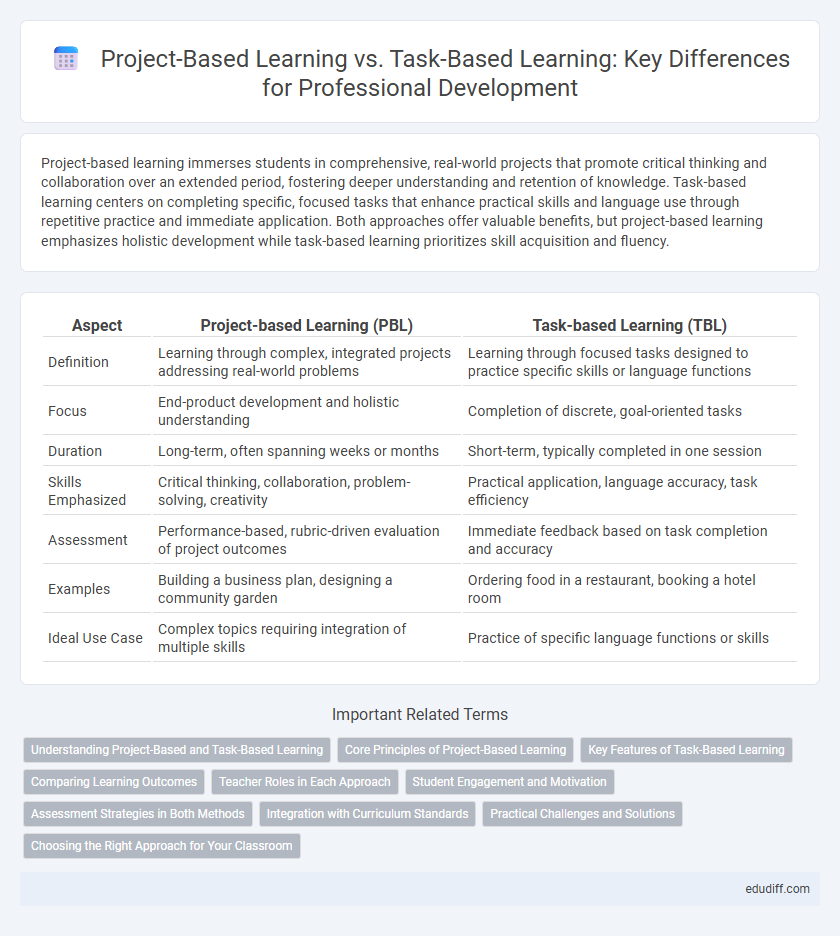Project-based learning immerses students in comprehensive, real-world projects that promote critical thinking and collaboration over an extended period, fostering deeper understanding and retention of knowledge. Task-based learning centers on completing specific, focused tasks that enhance practical skills and language use through repetitive practice and immediate application. Both approaches offer valuable benefits, but project-based learning emphasizes holistic development while task-based learning prioritizes skill acquisition and fluency.
Table of Comparison
| Aspect | Project-based Learning (PBL) | Task-based Learning (TBL) |
|---|---|---|
| Definition | Learning through complex, integrated projects addressing real-world problems | Learning through focused tasks designed to practice specific skills or language functions |
| Focus | End-product development and holistic understanding | Completion of discrete, goal-oriented tasks |
| Duration | Long-term, often spanning weeks or months | Short-term, typically completed in one session |
| Skills Emphasized | Critical thinking, collaboration, problem-solving, creativity | Practical application, language accuracy, task efficiency |
| Assessment | Performance-based, rubric-driven evaluation of project outcomes | Immediate feedback based on task completion and accuracy |
| Examples | Building a business plan, designing a community garden | Ordering food in a restaurant, booking a hotel room |
| Ideal Use Case | Complex topics requiring integration of multiple skills | Practice of specific language functions or skills |
Understanding Project-Based and Task-Based Learning
Project-based learning emphasizes comprehensive exploration of real-world problems through extended projects, fostering critical thinking, collaboration, and application of interdisciplinary knowledge. Task-based learning focuses on completing specific, practical tasks that enhance language or skill acquisition by promoting active use and immediate contextual relevance. Both approaches support experiential learning but differ in scope and depth, with project-based learning encouraging broader cognitive engagement and task-based learning targeting targeted skill development.
Core Principles of Project-Based Learning
Project-Based Learning (PBL) centers on engaging students in complex, real-world projects that require critical thinking, collaboration, and sustained inquiry, fostering deeper understanding and skill development. Its core principles include driving motivation through authentic problems, integrating interdisciplinary knowledge, and promoting reflection and self-assessment throughout the learning process. Unlike Task-Based Learning, which focuses on practical language or skill tasks, PBL emphasizes comprehensive project completion that mirrors professional and real-life scenarios.
Key Features of Task-Based Learning
Task-Based Learning (TBL) emphasizes real-world tasks as the primary unit of planning and instruction, fostering practical language use through problem-solving activities and authentic communication. Key features include learner-centeredness, meaningful context, and outcome-oriented tasks that promote critical thinking and collaboration. Unlike Project-Based Learning, TBL typically involves shorter, focused activities designed to achieve specific communicative goals within a well-defined timeframe.
Comparing Learning Outcomes
Project-based learning fosters deep understanding by engaging students in complex, real-world problems that develop critical thinking and collaboration skills. Task-based learning emphasizes practical language use and immediate application, enhancing communicative competence and fluency through focused, goal-oriented activities. Comparing learning outcomes reveals that project-based learning promotes long-term retention and higher-order cognitive skills, while task-based learning excels in improving functional usage and task completion efficiency.
Teacher Roles in Each Approach
In project-based learning, teachers act as facilitators who design complex, real-world projects and guide students through inquiry and collaboration, fostering critical thinking and problem-solving skills. In task-based learning, teachers focus on creating specific, goal-oriented tasks that promote language use and practical application, providing immediate feedback and scaffolding to support student progress. Both approaches require adaptive teacher roles to effectively engage learners and achieve distinct educational outcomes.
Student Engagement and Motivation
Project-based learning fosters deeper student engagement by involving learners in real-world problems that require sustained inquiry and collaboration, which enhances motivation through meaningful context and ownership of outcomes. Task-based learning centers on completing discrete tasks aimed at developing specific skills, triggering motivation via clear, achievable goals and immediate relevance. Both approaches boost student motivation differently: project-based learning supports intrinsic motivation through creativity and autonomy, while task-based learning encourages extrinsic motivation through structured progression and skill mastery.
Assessment Strategies in Both Methods
Project-based learning employs formative and summative assessments through presentations, peer reviews, and reflective journals to evaluate students' understanding and skills in real-world contexts. Task-based learning emphasizes performance-based assessments, such as task completion accuracy and fluency, to measure practical language or skill proficiency. Both methods integrate continuous feedback mechanisms to support learner progress and adjust instructional strategies effectively.
Integration with Curriculum Standards
Project-based learning aligns closely with curriculum standards by enabling students to explore complex real-world problems that require the application of interdisciplinary knowledge and skills. Task-based learning targets specific language or subject skills, providing focused practice that directly supports discrete curriculum objectives. Integrating both approaches ensures comprehensive coverage of standards while fostering critical thinking and practical application.
Practical Challenges and Solutions
Project-based learning often faces practical challenges such as resource allocation, time management, and ensuring student collaboration, which can be mitigated by structured planning, clear milestones, and integrating digital collaboration tools. Task-based learning struggles with defining measurable outcomes and maintaining learner engagement, solutions include designing tasks linked to real-world applications and incorporating continuous feedback mechanisms. Both approaches benefit from adaptive assessment strategies and leveraging technology to bridge gaps in communication and resource access.
Choosing the Right Approach for Your Classroom
Project-based learning fosters deep understanding through extended exploration of complex questions, promoting collaboration and critical thinking skills, making it ideal for classrooms seeking long-term engagement. Task-based learning emphasizes practical language use via focused, goal-oriented tasks that develop specific skills efficiently, suitable for settings with limited time or clear performance objectives. Selecting the right approach depends on curriculum goals, student proficiency levels, and available resources to maximize learning outcomes.
Project-based learning vs Task-based learning Infographic

 edudiff.com
edudiff.com